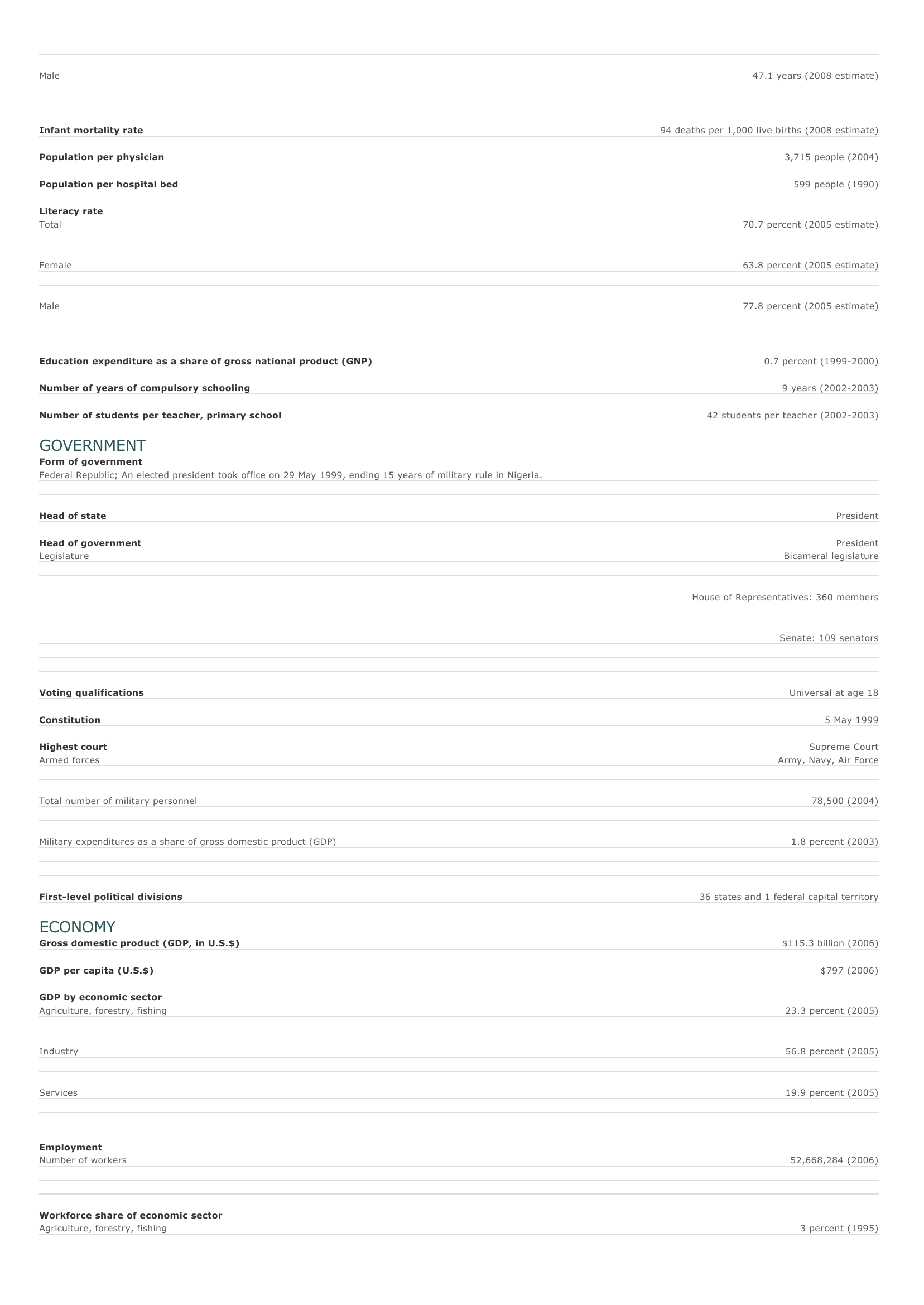
Nigeria Facts and Figures. BASIC FACTS Official name Capital Area Federal Republic of Nigeria Abuja 923,768 sq km 356,669 sq mi PEOPLE Population 138,283,240 (2008 estimate) Population growth Population growth rate 2.38 percent (2008 estimate) Projected population in 2025 206,165,946 (2025 estimate) Projected population in 2050 356,523,597 (2050 estimate) Population density 152 persons per sq km (2008 estimate) 393 persons per sq mi (2008 estimate) Urban/rural distribution Share urban 48 percent (2005 estimate) Share rural 52 percent (2005 estimate) Largest cities, with population Lagos Ibadan Ogbomosho Kano Oshogbo Ethnic groups Hausa, Fulani, Yoruba, and Igbos 11,100,000 (2005 estimate) 3,570,000 (2007 estimate) 861,300 (2007 estimate) 3,630,000 (2007 estimate) 465,000 (1995 estimate) 71 percent NOTE: The Hausa and Fulani live mostly in the north, the Yoruba in the southwest, and the Igbos in the southeast. Other groups 29 percent Languages English (official), Hausa, Yoruba, Igbo, Fulfulde, other indigenous languages Religious affiliations Muslim 50 percent Christian 40 percent Indigenous beliefs 10 percent HEALTH AND EDUCATION Life expectancy Total 47.8 years (2008 estimate) Female 48.5 years (2008 estimate) Male Infant mortality rate Population per physician Population per hospital bed 47.1 years (2008 estimate) 94 deaths per 1,000 live births (2008 estimate) 3,715 people (2004) 599 people (1990) Literacy rate Total 70.7 percent (2005 estimate) Female 63.8 percent (2005 estimate) Male 77.8 percent (2005 estimate) Education expenditure as a share of gross national product (GNP) Number of years of compulsory schooling Number of students per teacher, primary school 0.7 percent (1999-2000) 9 years (2002-2003) 42 students per teacher (2002-2003) GOVERNMENT Form of government Federal Republic; An elected president took office on 29 May 1999, ending 15 years of military rule in Nigeria. Head of state Head of government Legislature President President Bicameral legislature House of Representatives: 360 members Senate: 109 senators Voting qualifications Constitution Highest court Armed forces Total number of military personnel Military expenditures as a share of gross domestic product (GDP) First-level political divisions Universal at age 18 5 May 1999 Supreme Court Army, Navy, Air Force 78,500 (2004) 1.8 percent (2003) 36 states and 1 federal capital territory ECONOMY Gross domestic product (GDP, in U.S.$) GDP per capita (U.S.$) $115.3 billion (2006) $797 (2006) GDP by economic sector Agriculture, forestry, fishing 23.3 percent (2005) I ndustry 56.8 percent (2005) Services 19.9 percent (2005) Employment Number of workers 52,668,284 (2006) Workforce share of economic sector Agriculture, forestry, fishing 3 percent (1995) I ndustry 22 percent (1995) Services 75 percent (1995) Unemployment rate 3.2 percent (1997) National budget (U.S.$) Total revenue $11,408 million (1995 estimate) Total expenditure $11,722 million (1995 estimate) Monetary unit 1 naira (N), consisting of 100 kobo Agriculture Palm oil, peanut oil, rubber, cacao, cotton, sorghum, millet, maize (corn), yams, cassava, timber, and livestock Mining Petroleum, natural gas, coal, tin, columbite, limestone, iron ore, lead, zinc, gypsum, barite, kaolin Manufacturing Food products, brewed beverages, refined petroleum, iron and steel, motor vehicles, textiles, footwear, pulp and paper Major exports Petroleum, cacao beans, rubber, shrimp Major imports Machinery and transportation equipment, manufactured goods (mostly iron and steel, textiles, and paper products), chemicals, food products Major trade partners for exports United States, Spain, Brazil, France, and India Major trade partners for imports United Kingdom, United States, China, Germany, and France ENERGY, COMMUNICATIONS, AND TRANSPORTATION Electricity production Electricity from thermal sources 47.91 percent (2003 estimate) Electricity from hydroelectric sources 52.09 percent (2003 estimate) Electricity from nuclear sources 0 percent (2003 estimate) Electricity from geothermal, solar, and wind sources 0 percent (2003 estimate) Number of radios per 1,000 people 226 (1997) Number of telephones per 1,000 people 9 (2005) Number of televisions per 1,000 people 66 (2000 estimate) Number of Internet hosts per 10,000 people 0.09 (2003) Daily newspaper circulation per 1,000 people 24 (1996) Number of motor vehicles per 1,000 people 12 (1997) Paved road as a share of total roads 15 percent (2004) SOURCES Basic Facts and People sections Area data are from the statistical bureaus of individual countries. Population, population growth rate, and population projections are from the United States Census Bureau, International Programs Center, International Data Base (IDB) (www.census.gov). Urban and rural population data are from the Food and Agriculture Organization (FAO) of the United Nations (UN), FAOSTAT database (www.fao.org). Largest cities population data and political divisions data are from the statistical bureaus of individual countries. Ethnic divisions and religion data are largely from the latest Central Intelligence Agency (CIA) World Factbook and from various country censuses and reports. Language data are largely from the Ethnologue, Languages of the World, Summer Institute of Linguistics International (www.sil.org). Health and Education section Life expectancy and infant mortality data are from the United States Census Bureau, International Programs Center, International database (IDB) (www.census.gov). Population per physician and population per hospital bed data are from the World Health Organization (WHO) (www.who.int). Education data are from the United Nations Educational, Scientific and Cultural Organization (UNESCO) database (www.unesco.org). Government section Government, independence, legislature, constitution, highest court, and voting qualifications data are largely from various government Web sites, the latest Europa World Yearbook, and the latest Central Intelligence Agency (CIA) World Factbook. The armed forces data is from Military Balance. Economy section Gross domestic product (GDP), GDP per capita, GDP by economic sectors, employment, and national budget data are from the World Bank database (www.worldbank.org). Monetary unit, agriculture, mining, manufacturing, exports, imports, and major trade partner information is from the statistical bureaus of individual countries, latest Europa World Yearbook, and various United Nations and International Monetary Fund (IMF) publications. Energy, Communication, and Transportation section Electricity information is from the Energy Information Administration (EIA) database (www.eia.doe.gov). Radio, telephone, television, and newspaper information is from the United Nations Educational, Scientific and Cultural Organization (UNESCO) database (www.unesco.org). Internet hosts, motor vehicles, and road data are from the World Bank database (www.worldbank.org). Note Figures may not total 100 percent due to rounding. Microsoft ® Encarta ® 2009. © 1993-2008 Microsoft Corporation. All rights reserved.










